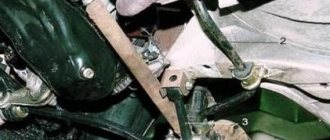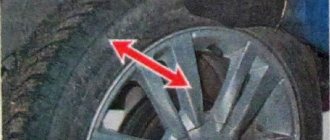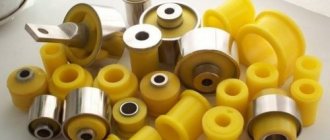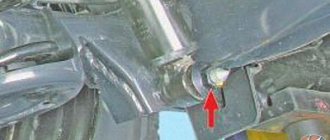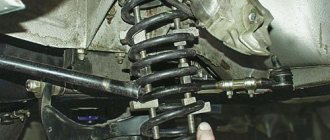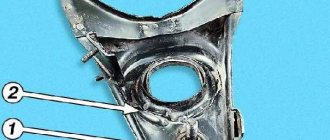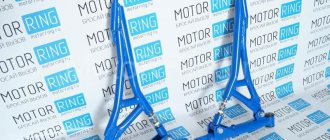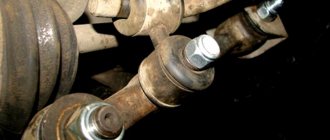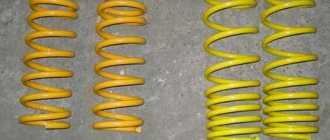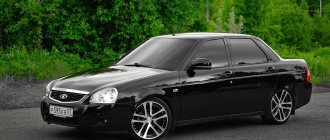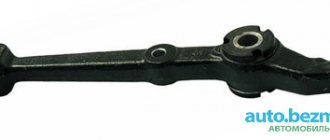Passenger cars of the “Tenth Family” were produced by the VAZ plant in the early 2000s. These include the Lada-112 hatchbacks, the design of which is considered the most successful. On the VAZ-2112 the front suspension is designed in the same way as on station wagons or sedans. And it is more complex than on all Logan family cars. The reason is the absence of triangular levers. But in the VAZ-2110 (2112) suspension you can adjust literally everything, while in Logan we only adjust the toe.
Sometimes the suspension unit is tuned. But what is shown in the video should not be repeated. Let's see...
Front suspension device
The front suspension
is independent, with telescopic swivel struts, wishbones, trailing arms and a stabilizer bar.
Front suspension:
1 - cross member; 2 — cross member bracket; 3 — adjusting washers of the front end of the extension; 4 — longitudinal stretch; 5 — telescopic stand; 6 — steering knuckle; 7 — adjusting washers of the rear end of the extension; 8 — ball joint; 9 — wishbone; 10 — stabilizer strut; 11 — rubber-metal hinge; 12 — car body bracket; 13 — stabilizer bar; 14 — rod cushion bracket
The suspension strut consists of a housing in which a hydraulic telescopic shock absorber is installed, a coil spring and an upper strut support. A bracket for attaching the steering knuckle, a swing arm and a lower spring support cup are welded to the outside of the strut body.
The coil spring rests with its lower coil on the lower support cup, and with its upper coil on the upper support cup mounted on the shock absorber rod. Also installed on the shock absorber rod is the upper support of the strut, consisting of a housing, a rubber cushion and a bearing. The support body is attached to the car body with three studs and nuts. The bearing allows the shock absorber rod to rotate in the support when the strut is turned, and the rubber buffer prevents the transfer of vibrations to the car body.
The shock absorber rod is protected from dirt and dust by a corrugated casing. In the event of a suspension breakdown, the stroke of the rod is limited by the compression stroke buffer.
The strut pivot arm is connected to the steering rod through a ball pin. Changing the length of the rod using its threaded insert allows you to adjust the toe-in of the front wheels.
1 — tie rod end 2 — threaded insert; 3 — steering rod; 4 — telescopic stand; 5 - rotary lever
The steering knuckle is attached to the strut bracket with two bolts and nuts. The upper hole of the bracket is made oval, and the bolt installed in it has an eccentric collar and an eccentric washer. When the top bolt is turned, the steering knuckle moves along the radius the required distance, using the bottom bolt as the axis of rotation. Thanks to this, the angle between the strut and the fist changes, which in turn allows you to adjust the camber of the front wheel.
1 — bracket for fastening the steering knuckle; 2 — rack body; 3 - upper (eccentric) steering knuckle mounting bolt; 4 - lower steering knuckle mounting bolt; 5 - steering knuckle
A double-row ball bearing is pressed into the hole of the steering knuckle and secured with two retaining rings. The wheel hub is pressed into the inner ring of the bearing.
At the bottom, the steering knuckle is connected to the wishbone of the suspension using a ball joint. The transverse lever is kept from moving by a stretcher, which is attached at its rear end through a rubber-metal hinge to the lever, and at the front end through a cushion to the cross member. By changing the number of washers in the front and rear brace mounts, you can change the position of the lever, thereby adjusting the longitudinal inclination of the steering axis.
1 — rear end of the longitudinal extension; 2 — adjusting washers; 3 - thrust washer; 4 — rubber-metal hinge; 5 - transverse suspension arm
The ends of the anti-roll bar are connected by struts to the wishbones of the vehicle's front suspension. The central part of the stabilizer is secured through rubber pads to the body. The movement of one of the levers is transmitted through the stabilizer to the second. This allows you to partially synchronize the operation of both sides of the suspension and thereby reduce the sway of the car on uneven roads and roll in corners.
Source
Replacing a broken spring
To replace the spring (which also cannot be repaired), you need to remove the shock absorber and disconnect it from the roll bar. After this, you need to loosen the screws of the lower arm, after that it is jacked up, then using a special puller we remove the ball pin.
Now you can slowly release the jack, as a result of which the spring weakens and is easily removed from the cup.
Attention! A new spring can be placed in the support bowl only by first tightening it with a special tie. After this, the lower arm is pressed in the same way, then its ball joint enters the steering knuckle
Then you can release the spring from the tie. Shown is a diagram of spring compression using a tie
After this, the lower arm is pressed in the same way, then its ball joint fits into the steering knuckle. Then you can release the spring from the tie. A diagram of spring compression using a tie is shown.
In conclusion, it must be said that a novice motorist is quite capable of monitoring the serviceability of the suspension, the main thing is that he has an overpass or a pit at his disposal.
The suspension of any car consists of many different parts that have different functions. One of these parts is a ball joint, which is a connecting part that allows the front wheels to rotate in different directions. If a part malfunctions, serious consequences can arise, so we will figure out how to check the ball joint of a VAZ 2107, and what may be needed for this.
Review of the front suspension of the VAZ-2112 and what parts it includes: structure and diagram
Passenger cars of the “Tenth Family” were produced by the VAZ plant in the early 2000s. These include the Lada-112 hatchbacks, the design of which is considered the most successful. On the VAZ-2112 the front suspension is designed in the same way as on station wagons or sedans. And it is more complex than on all Logan family cars. The reason is the absence of triangular levers. But in the VAZ-2110 (2112) suspension you can adjust literally everything, while in Logan we only adjust the toe.
Sometimes the suspension unit is tuned. But what is shown in the video should not be repeated. Let's see...
What kind of tuning does the G7 suspension undergo?
In general, the VAZ-2107 car is very similar to the already outdated “penny”. The latter is completely copied from the Fiat-124. Therefore, many motorists try to improve the design as much as possible in order to achieve higher performance. Tuning will allow you to achieve the following results:
- Improve ride smoothness.
- Significantly improve vehicle handling.
- Significantly improve stability when driving at high speed.
- Increase the durability and reliability of all structural elements.
The easiest way of tuning is to install higher quality products on the car, which are produced by foreign companies. In particular, this applies to shock absorbers, the fine selection of which can solve a lot of problems, as well as “tailor” the car to specific needs. You can make it either soft and smooth, or hard but more stable when driving at high speeds.
Front suspension - complete assembly
The photo shows what the right disc suspension looks like. It is easy to recognize the telescopic post 6, as well as the lever 3. Both of these parts form the basis of the assembly.
We list the main parts in ascending order of number: 1 – anti-roll bar; 2 – stabilizer rod; 3 – suspension arm; 4 – ball joint; 5 – steering knuckle; 6 – suspension strut; 7 – stretch (saber); 8 – extension bracket.
Parts 7 and 3 could constitute a "monolith". But even then they would be mounted on hinges, and in the suspension design of the VAZ-2112 (and 2110) we will find these hinges plus one more - it connects parts 3 and 7.
The photo does not show the swing arm, but here it is attached to the shock absorber, that is, it is part of it.
The main part is a strut with a shock absorber
Everything that is indicated above by the number 6 consists of several parts. Let's list them.
The numbers indicate the elements:
- 2108-2901056 – metric nut M14;
- 2110-2902760 - cup;
- 10519601 - washer;
- 16105021 – self-locking nut M12;
- 2110-2902816 – bump stop;
- 2110-2905003 and 2110-2905002 – shock absorber left and right;
- 2110-2902826 - frame;
- 2108-2901052 – washer for screw;
- 15540931 – M12 screw (until 07.2001);
- 2108-2901051 – lower screw (after 07.2001);
- 2110-2901054 – cap;
- 2110-2902842 - washer;
- 2110-2902830 – screw;
- 2110-2901032 - washer;
- 2110-2902820 – upper support (pillow);
- 2112-2902712 – suspension spring;
- 2112-2901031 and 2112-2901030 – left and right rack;
- 2110-2905681 – anther;
- 2108-2901050 – screw with eccentric;
- 16104111 – self-locking nut M8;
- 2108-2902840 (-01, -02) or 2110-2902840 (-01) – support bearing.
Some station wagons and sedans have racks 2110-2901030 and 2110-2901031. But then springs 2108-2902712 are used. But the parts marked with the number 21 are interchangeable.
Rounded fist
Let's consider one important unit, consisting of a minimum number of parts.
Steering knuckle with hub bearing
From the appearance of the unit it is clear what and how it is attached to. Let's list the articles:
- 2108-3103020-01 (-02) – wheel bearing;
- 2108-3103068 – sealing ring;
- 2108-3001060 – dirt protection lining (internal);
- 2108-3103012 – hub;
- 2108-3103079 – bearing element (washer);
- 2108-3103032 – a retaining ring that secures the bearing;
- 2108-3001061 – dirt protection pad (external);
- 2110-3103065 – decorative cap (after 01.2003);
- 2108-3103065 – decorative cap (until 01.2003);
- 2108-3001015 and 2108-3001014 – left and right fist;
- 2108-3103061 – hub mudguard;
- 14044271 – self-locking nut M20.
Diagram of the anti-roll bar on the VAZ-2112
The stabilizer is an important part, but you can drive without it. The absence of a stabilizer is not a reason to remove the car from service.
Stabilizer and traction rod
The unit consists of a rod and two rods. Articles:
- 2110-2906050 – thrust or stand;
- 2110-2906010 – assembly assembly;
- 10516870 – spring washer;
- 2110-2906040 - pillow;
- 10519601 - washer;
- 2108-2906042 - bracket;
- 2110-2906016 – rod;
- 2110-2906078 – upper rod bushing;
- 15971321 – M10 screw;
- 12164711 – nut M10;
- 16104111 – self-locking nut M8;
- 2108-2906079 – lower rod bushing.
To get rid of the stabilizer, remove the parts shown in the list.
Main front suspension components
The main element of the front suspension is considered to be a hydraulic telescopic strut , which is simply irreplaceable in the matter of shock absorption and ensuring a comfortable ride on the car. The car won’t shake much, and going through every hole won’t turn your trip into a nightmare.
To change the wheel camber, there is a strut in the front suspension. To be more precise, the steering knuckle and the upper bolt, which has an eccentric washer and a belt, are responsible for this process.
- Special springs;
- Buffer to limit the compression stroke. On the VAZ 2110 this element is made of polyurethane;
- Upper support. It is attached to the rack, to which, in turn, the mudguard is attached. Please note that only self-locking nuts are used for fixing. Therefore, ordinary nuts will not work for repairs;
- Bearing to ensure rotation of the stand together with the wheels;
- Shock absorbers with spring and plunger.
The ball joint serves to combine the steering knuckle and the lever, that is, the lower part of the suspension. Rubber-metal hinges combine the lower arms, longitudinal braces, and cross member supports.
By the way, the cross member of the front suspension of the VAZ 2110 is a bar to which the lower arms are connected. In the center it is attached to the body using a rubber cushion.
This is a brief diagram of the front suspension of the VAZ 2110, your instruction manual will help you get to know it better. Many motorists underestimate the importance of this literature, which the manufacturer attaches to each of its cars. But in fact, the necessary, useful and important information about each component, unit and system of the machine is presented in detail and in all colors. Including the front suspension, of course.
Interior
The interior of the car is simple and not very presentable. You won’t find any “bourgeois excesses” here. The only exception is electric windows and heated front seats, but this is not found in all modifications of the car.
The steering wheel is large and very antediluvian. The steering column is height adjustable only. Moreover, some models come without power steering and electric power steering, which is a significant disadvantage.
Torpedo Lada 2112 (2006-08)
To the right of the steering wheel is a console with a heater, radio, on-board computer (if equipped) and main keys. The heater, in theory, should be adjustable in order to separately heat the windows, top and bottom of the cabin, but in reality everything is heated at once. There are no airbags in the cabin.
The glove compartment is quite large and even has a backlight. The position of the exterior mirrors is adjusted by a special lever, but it is adjusted very mediocrely, so usually no one uses it.
A tall person is unlikely to be comfortable in the back row of seats, because his head will touch the ceiling. Long-legged people will also not be very comfortable, since there is quite a bit of space left to the front seats. The width of the cabin is cramped; only two passengers can be comfortably accommodated. Three people will fit, but they will be cramped.
Interior of Lada 2112 (1999–2008)
The rear windows are manual and constantly stick. As anyone who has ever owned a Lada, Zhiguli or any other AvtoVAZ product knows, the windows go down exactly to the level they want. Often it is completely impossible to lower the glass completely; it gets stuck in the middle and does not move anymore.
The rear row seats recline together or separately, which increases the size of the trunk, so you can put a fairly large load in the car.
Knocks
If you start to hear knocking noises coming from the front suspension, this could be caused by several reasons:
- The rack has certain faults;
- The ties on the cross member, the cushions are worn out or the bolts are loose;
- The attachment to the body was not strong enough;
- The springs have failed;
- The hinges are worn out;
- The rubber part of the suspension has broken its integrity. The knock should be clear, like the impact of metal on metal;
- Wheel alignment is out of balance.
If you do not hear a knock, but a noise, then the causes of front suspension problems may be as follows:
- The bolts that secure the stabilizer bar to the body have become loose;
- The rubber components in the strut support have collapsed;
- The rubber pads of the coupler or rod are worn out;
- The suspension spring has broken or violated its geometry;
- The wheels are unbalanced;
- The compression stroke buffer has collapsed.
Why does the car pull to the side?
Sometimes drivers notice how, when driving in a straight line, the car begins to pull to the side. There are several reasons for this phenomenon:
- Each spring has its own specific compression ratio. If it loses elasticity, the element must be replaced;
- Tires may have different pressures. Check this first;
- A rubber component on one of the strut supports has collapsed. In such a situation, a characteristic knock may appear. The situation can be corrected by simply replacing the element;
- The wheels are set at the wrong angle. A common cause of tire wear. It is better to trust such a problem to a specialist, since it is difficult to repair the front suspension on a VAZ 2110 with your own hands in case of such a malfunction.
DIY car suspension diagnostics
The service life of suspension components varies greatly in different countries, and this is due to the quality of the road surface. If the suspension rarely changes abroad, then in the case of Russian roads, suspension elements have to be changed every year, and sometimes more than once. How can you determine suspension wear yourself?
Examination
To prevent you from having problems while driving on the road, it is strongly recommended to check the front suspension for preventive purposes, and also to respond immediately when the first signs of trouble appear.
- Experts recommend paying special attention to the protective covers of the joints, monitoring their condition, and also checking the front suspension for mechanical damage.
- Make sure that neither the front suspension arm of the VAZ 2110 nor any other element has cracks or other visible damage. Pay attention to checking the connection points of the elements.
- If the components are deformed, the angle of the wheels will most likely be disrupted and they will no longer be able to be adjusted.
- Check ball joints, hinges, upper stack mounts, cushions. If there are breaks in the rubber elements, they must be replaced.
- Measure the distance between the lower arm and the brake disc. This way you can check the condition of the suspension joint. If the distance is more than 0.8 millimeters, the hinge must be replaced with a new one.
- If the buffer shows signs of destruction, it should be replaced immediately.
- The spring is replaced if it has failed or sagged.
- Ball joints are replaced when they are worn or deformed. Other hinges must be replaced if they or the stabilizer bar struts are worn out.
- All rubber elements change under conditions of deformation or failure.
- If the fastening of the upper strut mount to the body is loose, simply try to tighten the fastening. Most likely, no major intervention will be required.
Understanding the structure of the front suspension, as well as audibly or visually identifying its malfunctions is quite simple, despite the apparent complexity of the assembly. But you should approach the issue carefully and periodically check the condition of the suspension, even if its malfunction is not indicated by any noise, knocking or behavior of the car on the road.
For any car, it is better to organize preventive maintenance than to later pay exorbitant prices for a full repair. Like a disease, it is better to prevent problems with the front suspension of the VAZ 2110 from occurring. It is cheaper, simpler and more correct on the part of the car owner.
A detailed video about the suspension and brakes
Welcome! Front transverse arms - installed in the front of the car on the sides, over time they (from bad roads) can become deformed, and also in the event of a strong collision with a deep hole or when flying at speed onto a curb, the arms are most likely the very first to fail , not counting the wheels and some other suspension elements, so after that you have to change them, in this same article we will teach you how to change the transverse front control arms on cars of the tenth family, in addition, we will also show where they are located and explain what symptoms they will have car if any of the levers is deformed.
Note! To replace both wishbones (one is located on the left side of the car and the other on the right), stock up on: All the keys that you have in your toolbox, in addition to this you will need a bit and you will have to find an inspection hole somewhere, because the levers are located at the bottom car and you will have to crawl under it, you also need a jack and a wheel wrench to remove the required wheel from the car in which the front suspension wishbones will be replaced!
Where are the front wishbones? We will not insert a picture in this article, because in one article we already described where these levers are located, but still we will explain a little, in order to see them you will have to crawl under the bottom of the car and there will be many levers, starting from two transverse ones and ending with anti-roll bar, for more details about where the wishbones are located, see the article entitled: “Replacing the front wishbones on a VAZ”, they are shown there with a red arrow in the photo.
When do you need to replace front wishbones? We won’t tell you exactly how the car will behave if they are bent, but we will try to convey to you in what cases they need to be checked, firstly, what is a lever, this is the thing that holds the wheels of the car in a vertical position and does not give up when hitting It’s too much for them to move away from this position, the levers themselves are durable and rarely will anyone change them, but if any accident occurs or the car hits a hole at high speed, then there is a possibility that the levers were deformed upon impact and thus became unusable, where they are located we have already told you, so as soon as you feel that after hitting a hole when you release the steering wheel, the car is leading somewhere to the side, although you have never had this before, then here we recommend that you crawl under car and look at the condition of these levers and, if necessary, replace them with new ones, in addition, from time to time the levers become corroded and do not rust much, so if you notice rust on them, then in this case we also recommend replacing them with new ones, just over time that’s all get worse and definitely won’t lead to anything good (metal also weakens from rust and when you hit even a small bump, the lever will most likely become deformed).
Loading, Please Wait!
This may take a second or two.
Before you start repairing anything, you need to know how it works. Therefore, the first article in this section is the design of the front suspension. What is front suspension and what does it consist of?
The suspension is the parts, components and mechanisms that connect the car body to the wheels. The purpose of the suspension is to reduce dynamic loads on the supporting elements. The VAZ 2110 has an independent, telescopic front suspension.
It is based on hydraulic shock absorbers, coil springs, levers with extensions, and a stability stabilizer. Let's look at the picture of everything that is included in it:
1 – ball joint 2 – hub 3 – brake disc 4 – protective cover 5 – swing arm 6 – lower support cup 7 – suspension spring 8 – telescopic strut protective cover 9 – compression buffer 10 – upper support cup 11 – upper support bearing 12 – upper strut support 13 – rod nut 14 – rod 15 – compression buffer support 16 – telescopic strut 17 – nut 18 – eccentric bolt 19 – steering knuckle 20 – front wheel drive shaft 21 – hinge protective cover 22 – outer shaft joint 23 – lower arm Let’s Let's see what the front suspension looks like when you look at it from under the car:
1 – suspension arm extension 2 – anti-roll bar 3 – suspension arm The upper support is attached to the car body, namely to the mudguard strut, with 3 nuts. Due to the fact that the support is quite elastic, the stand can swing during the suspension stroke. This is good because body vibrations are damped. And the bearing installed in it makes it possible to rotate the rack in the same way as turning the wheels.
There is a hydraulic shock absorber installed inside the strut housing; if it fails, it can be replaced. The steering knuckle 19 is connected to the lever 23 by means of a ball joint 1. The support is secured with 2 bolts; when unscrewing them, it is worth tapping them and spraying them with WD-40, since they often break when pressed hard.
Traction and braking forces are received by longitudinal braces, which are connected with silent blocks to the beam and lower arms.
In the middle part of the anti-roll bar there is a bend for the exhaust pipe. The lower arms are connected to the ends of the stabilizer by rubber-metal hinges. In turn, the stabilizer bar is secured with fasteners, inside of which rubber cushions are inserted.
(votes: 3, average: 5.00 out of 5).
Hi all!
Today I’ll tell you
about the front suspension
, there will be a little theory and the final result that I have.
So, the front suspension.
Our tens have single wishbone suspension at the front. Not the best option, but we are content with what we have. With a strong understatement (I mean -110 and below), the suspension geometry changes very much. Namely, in the stock state, the lever is raised very high (and if there is also a stabilizer, but it is generally compressed as much as possible), the steering rod, if not moved on the rack, also lifts up into the sky.
A little theory.
Before perceiving the information, I recommend reading
this book
, not necessarily all of it, but specifically the sections
“Chapter 2. Suspension Height”
,
“Chapter 3. Suspension Geometry”
and
“Chapter 6. Angles and Shock Control”,
it is advisable to study, maybe I’ll do something I didn’t understand it correctly, but I’ll try to briefly tell you how I understood it now.
When lowering the car, you must always remember the position of the lower arm and steering rod. Attention! All positions are considered from hinge to hinge, and not according to the geometry of the lever and rod itself.
Our task is to ensure that in the driving position the lower arm is as parallel to the ground as possible, and the steering rod is also parallel to the horizon, and at the same time, they must be parallel to each other. The permissible deviations in both cases are about 1.5 mm in each direction. In this case, we have the most correct front suspension geometry (in theory), with no “shock control”. When hanging, such a car will have a strongly negative toe-in, which also indicates that the geometry has been properly prepared. In theory everything is fine, but how it turns out in practice will be known later.
Repair of VAZ 2110 Lada Chassis
4.0 Chassis
Telescopic stand 1 – compression valve body; 2 – compression valve discs; 3 – throttle disk of the compression valve; 4 – compression valve plate; 5 – compression valve spring; 6 – compression valve cage; 7 – recoil valve nut; 8 – recoil valve spring; 9 – valve plate from...
4.1. Checking the technical condition of suspension parts on a car (Category). See the list of materials inside...
4.2. Rear suspension (Category). See the list of materials inside...
↓ Comments ↓
1. General data 1.0 General data 1.1. Vehicle Specifications
2. Engine 2.0 Engine 2.1 Possible engine malfunctions. 2.2 Replacing the coolant 2.3 Replacing the engine oil and oil filter 2.4. Installing the piston of the first cylinder to the TDC position of the compression stroke 2.5 Replacing the camshaft drive belt and tension roller 2.6 Adjusting the camshaft drive belt tension 2.7 Removing, troubleshooting and installing the flywheel 2.8. Replacing engine seal parts 2.9 Cylinder head 2.10 Grinding in valves 2.11 Adjusting clearances in valve drive 2.12 Removing and installing engine 2.13. Engine repair 2.14. Lubrication system 2.15. Cooling system 2.16. Exhaust gas system 2.18. Features of VAZ-2112 engine repair
3. Transmission 3.0 Transmission 3.1. Clutch 3.2. Gearbox 3.3. Front wheel drives
4. Chassis 4.0 Chassis 4.1. Checking the technical condition of suspension parts on the car 4.2. Rear suspension
5. Steering 5.0 Steering 5.1 Inspection and check of the steering on the car 5.2. Steering column 5.4. Steering mechanism 5.5 Possible steering malfunctions.
6. Brake system 6.0 Brake system 6.1. Vacuum booster 6.2. Main brake cylinder 6.3. Pressure regulator 6.4. Brake hoses and tubes 6.5 Bleeding the brake system 6.6 Replacing brake fluid 6.7. Front wheel brakes 6.8. Braking mechanisms of the rear wheels 6.9. Parking brake 6.10 Possible malfunctions of the brake system.
7. Electrical equipment 7.0 Electrical equipment 7.1. Mounting block 7.2. Generator 7.3. Starter 7.4. Ignition switch (lock) 7.5. Checking and replacing spark plugs 7.6. Integrated engine management system (fuel injection system) 7.7. Contactless ignition system 7.8. Lighting, light and sound signaling 7.9. Windshield wiper 7.10 Replacing the electric motor of the radiator fan of the cooling system 7.11. Heater electric motor 7.12. Cigarette lighter 7.13. Instrument cluster 7.14 Checking the carburetor solenoid valve control unit 7.15 Possible malfunctions of the EPHH control unit. 7.16 Electrical diagram of a VAZ-21102 car 7.17 Electrical diagram of a car with a carburetor engine 2110 7.18 Engine control diagram 2111 (pin M1.5.4) 7.19 Engine control diagram 2111 (pin MP7.0) 7.20 Control diagram for engines 2111 and 2112 (pin M1) .5.4N, "January-5.1")
8. Body 8.0 Body 8.1 Possible body malfunctions. 8.2. Replacing the buffers 8.3 Removing and installing the radiator trim 8.4 Removing and installing the locker 8.5 Removing and installing the wing 8.6. Hood 8.7 Removing and installing upholstery, trim and windshield frame lining 8.8. Trunk lid 8.9. Side doors 8.10 Removing and installing the front seat 8.11 Removing and installing the upper and lower lining of the floor tunnel 8.12. Seat belts 8.13. Rear view mirrors 8.14. Instrument panel 8.15. Heater 8.16 Anti-corrosion compounds for body treatment 8.17. Features of body repair of models 2111 and 2112 8.18. Body care
9. Appendices 9.0 Appendices 9.1 Fuels, lubricants and operating fluids 9.2 Basic data for adjustments and control 9.3 Filling volumes 9.4 Lamps used in the car
